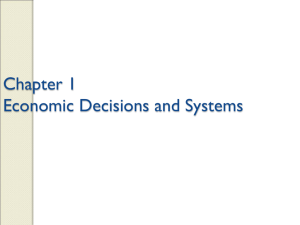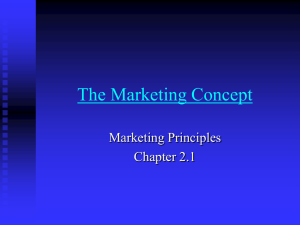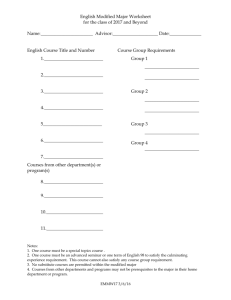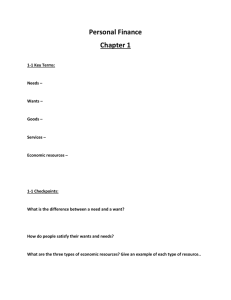Specific Objectives
advertisement
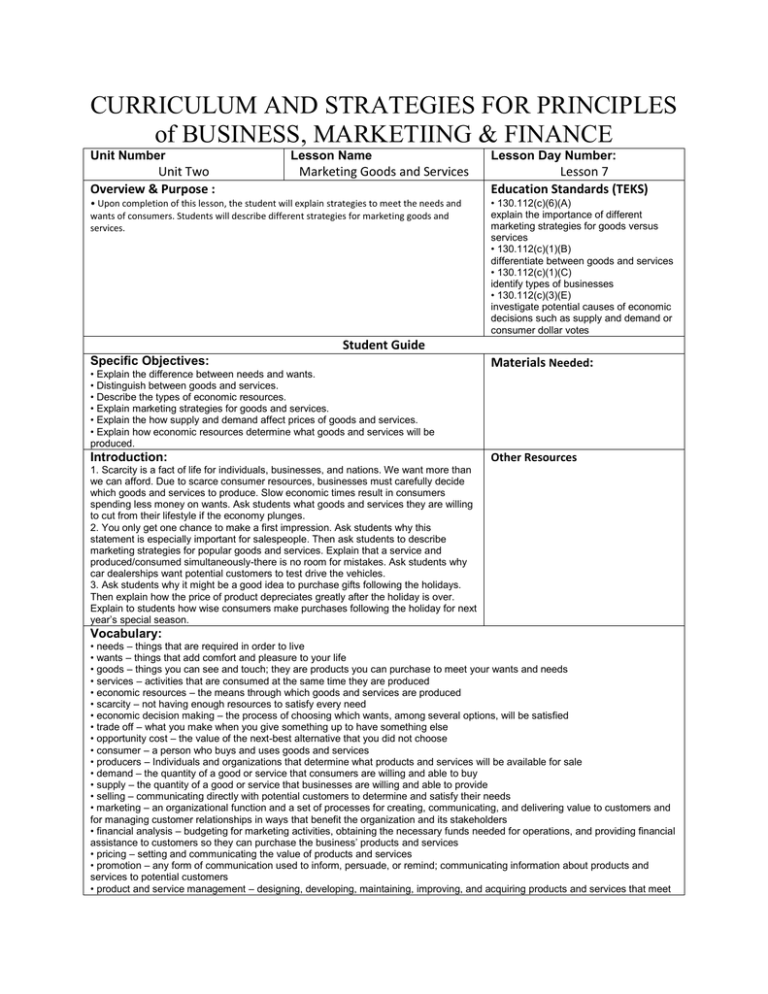
CURRICULUM AND STRATEGIES FOR PRINCIPLES of BUSINESS, MARKETIING & FINANCE Unit Number Unit Two Overview & Purpose : Lesson Name Marketing Goods and Services • Upon completion of this lesson, the student will explain strategies to meet the needs and wants of consumers. Students will describe different strategies for marketing goods and services. Lesson Day Number: Lesson 7 Education Standards (TEKS) • 130.112(c)(6)(A) explain the importance of different marketing strategies for goods versus services • 130.112(c)(1)(B) differentiate between goods and services • 130.112(c)(1)(C) identify types of businesses • 130.112(c)(3)(E) investigate potential causes of economic decisions such as supply and demand or consumer dollar votes Student Guide Specific Objectives: • Explain the difference between needs and wants. • Distinguish between goods and services. • Describe the types of economic resources. • Explain marketing strategies for goods and services. • Explain the how supply and demand affect prices of goods and services. • Explain how economic resources determine what goods and services will be produced. Introduction: Materials Needed: Other Resources 1. Scarcity is a fact of life for individuals, businesses, and nations. We want more than we can afford. Due to scarce consumer resources, businesses must carefully decide which goods and services to produce. Slow economic times result in consumers spending less money on wants. Ask students what goods and services they are willing to cut from their lifestyle if the economy plunges. 2. You only get one chance to make a first impression. Ask students why this statement is especially important for salespeople. Then ask students to describe marketing strategies for popular goods and services. Explain that a service and produced/consumed simultaneously-there is no room for mistakes. Ask students why car dealerships want potential customers to test drive the vehicles. 3. Ask students why it might be a good idea to purchase gifts following the holidays. Then explain how the price of product depreciates greatly after the holiday is over. Explain to students how wise consumers make purchases following the holiday for next year’s special season. Vocabulary: • needs – things that are required in order to live • wants – things that add comfort and pleasure to your life • goods – things you can see and touch; they are products you can purchase to meet your wants and needs • services – activities that are consumed at the same time they are produced • economic resources – the means through which goods and services are produced • scarcity – not having enough resources to satisfy every need • economic decision making – the process of choosing which wants, among several options, will be satisfied • trade off – what you make when you give something up to have something else • opportunity cost – the value of the next-best alternative that you did not choose • consumer – a person who buys and uses goods and services • producers – Individuals and organizations that determine what products and services will be available for sale • demand – the quantity of a good or service that consumers are willing and able to buy • supply – the quantity of a good or service that businesses are willing and able to provide • selling – communicating directly with potential customers to determine and satisfy their needs • marketing – an organizational function and a set of processes for creating, communicating, and delivering value to customers and for managing customer relationships in ways that benefit the organization and its stakeholders • financial analysis – budgeting for marketing activities, obtaining the necessary funds needed for operations, and providing financial assistance to customers so they can purchase the business’ products and services • pricing – setting and communicating the value of products and services • promotion – any form of communication used to inform, persuade, or remind; communicating information about products and services to potential customers • product and service management – designing, developing, maintaining, improving, and acquiring products and services that meet consumer needs Outline: I. Marketing Goods and Services A. Needs and Wants 1. Needs are required in order to live (food, water, clean air, clothing, shelter) 2. Wants-things that add comfort and pleasure to your life B. Needs and Wants are Unlimited C. Goods and Services 1. goods-things that you can see and touch (tangible) 2. services-activities that are consumed at the same time they are produced (intangible) D. Goods and Services for Businesses and Consumers 1. Business needs steel, plastic, gasoline, computers (goods) 2. Business needs supply of electricity, security for buildings and equipment, accounting (services) 3. Consumers buy clothes, electronic devices, automobiles (goods) 4. Consumers eat at restaurants, go on vacations, and take flights (services) E. U.S. Economy-largest producer of goods and services in the world 1. twice as many shopping malls as it does high schools 2. America-leader in consuming goods and services 3. Use of credit a. increased purchasing power b. led to more debt II. Economic Resources A. Means through which goods and services are produced (Factors of Production) 1. natural resources 2. human resources 3. capital resources B. Resources are limited C. Basic Economic Problem-Scarcity-not having enough resources to satisfy every need D. Economic Decision-making 1. scarcity forces individuals, businesses, and governments to make choices 2. economic decision-making (process of choosing which wants, among several options, will be satisfied) 3. trade-off-when you give up something to have something else 4. opportunity cost-the value of the next-best alternative that you did not choose E. The Decision-Making Process 1. Define the problem. 2. Identify the choices. 3. Evaluate the advantages and disadvantages of each choice. 4. Choose one choice. 5. Act on your choice. 6. Review your decision. III. Supply and Demand A. Consumer-person who buys and uses goods and services B. Producers-individuals and organizations that determine what products and services will be available for sale C. Consumers set demand-the quantity of a good or service that consumers are willing and able to buy D. Supply-the quantity of a good or service that businesses are willing and able to provide IV. Determining Price A. Factors Influencing Demand 1. high demand equals high prices 2. more choices (competition)-lower prices B. Factors Influencing Supply 1. more competitors results in a greater supply 2. little competition results in less supply and higher prices C. Market price-point where supply and demand are equal V. Marketing Goods and Services A. Determine Consumer Buying Motives B. Show and Demonstrate Goods C. Distribution-determining the best ways for customers to locate, obtain, and use products and services of an organization Ask students to make a list of their wants. Then ask students what is keeping them from getting their wants. Ask students what things consumers cut from spending when economic conditions become bad. Ask students why shopping malls have an increasing number of open spaces for stores. Explain how the economy is directly related to consumer demand and spending. Demand and spending is directly related to the rate of employment. Ask students to explain the advantages and disadvantages of using credit to make purchases. Ask students to make a list of the greatest resources in the United States. Then ask how the resources are used in a global business setting. Ask students to list a major decision they must make. Then ask students to incorporate the steps of the decisionmaking process to make their decision. Ask students what happens to prices when there is a shortage of goods. Then explain what consumers do when shortages and rising prices exist. They find other alternatives or do without certain goods and services. Ask students what price they are willing to pay for their favorite concert or sporting event. Then explain how prices rise according to consumer demand. Explain how a ticket to the Super Bowl costs well over $1,000. Different strategies are used to market goods and services. Marketers must research the target market to determine needs, wants, and demand. Sales are enhanced with solid demonstrations of goods. Services frequently count on word-of-mouth of satisfied customers. During a tight economy, businesses become increasingly aware of the importance of outstanding customer service. D. Product and Service Management-designing, developing, maintaining, improving, and acquiring products and services that meet consumer needs E. Selling-communicating directly with potential customers to determine and satisfy their needs F. Marketing-information management-obtaining, managing, and using market information to improve business decision-making and the performance of marketing activities G. Financial analysis-budgeting for marketing activities, obtaining the necessary funds needed for operations, and providing financial assistance to customers so they can purchase the business’ products and services H. Pricing-setting and communicating the value of products and services I. Promotion-communicating information about products and services to potential customers Looking Forward: Q: What is scarcity? A: Scarcity is not having enough resources to satisfy every need. Q: What is the difference between a need and a want? A: A need is required to live and a want adds comfort and pleasure to your life. Q: How do people satisfy their wants and needs? A: People purchase goods and services to satisfy their needs and wants. Q: What are three types of economic resources? A: Three economic resources are natural resources, human resources, and capital resources. Q: What is opportunity cost? A: Opportunity cost is the value of the next-best alternative that you did not choose. Q: What are the six steps in the decision-making process? A: The six steps are (1) define the problem, (2) identify the choices, (3) evaluate the advantages and disadvantages of each choice, (4) choose one, (5) act on your choice, and (6) review your decision. Q: How does the price of a product affect demand and supply? A: Prices have a direct impact on the amount supplied and the amount demanded. Less is demanded when prices go up. Higher prices encourage suppliers to provide more. Q: How is market price for a product determined? A: Market price is the point where supply and demand are equal. U.S. CENSUS BUREAU RESEARCH Ask student to use the Internet to access the Census Bureau’s web site and locate the link to “Economic Indicators.” Students should select one of the indicators and prepare a short PowerPoint presentation that indicates how the economic indicator changed over the last ten years. The presentation will be evaluated using the assigned rubric.
